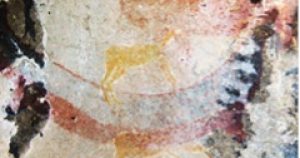
A re-examination of a two hundred-year-old rock painting in South Africa has revealed that the culture that produced the images may have been aware of a creature that lived over 260 million years ago, one that was a part of Indigenous folklore long before its discovery by modern paleontologists in 1845. Although knowledge of the supposedly-extinct reptile is assumed to have come from Indigenous knowledge of fossils of the creature, there are reports of more contemporary encounters with the beast, meaning it is possible that the artists may have been depicting a living creature they witnessed themselves.
Found amongst the rock paintings that adorn the cliffs found in South Africa’s La Belle France is a depiction of an elongated walrus-like creature called the Horned Serpent. Painted no later than two hundred years ago by the ǀXam-ka ǃʼē people, the creature closely resembles a tusked, albeit toothless, reptile called a dicynodont that lived during the Permian era 260 million years ago.
“The painting was made in 1835 at the latest, which means this dicynodont was depicted at least ten years before the western scientific discovery and naming of the first dicynodont by Richard Owen in 1845,” explained evolutionary biologist Julien Benoit, who published a paper on the subject.
“This work supports that the first inhabitants of southern Africa… discovered fossils, interpreted them and integrated them in their rock art and belief system.”
The petroglyphs are located in the Karoo Basin, a region that has proven to be a treasure trove of fossils, with dicynodont fossils being a common find amongst the ossified remains, meaning the ǀXam-ka ǃʼē would have been well aware of the creatures’ strange skeletons.
In addition to the overall shape of the creature in the painting, “the skin of the tusked animal is dotted, which is not unusual in San rock art, but is also consistent with the warty mummified skin preserved in some dicynodont fossils in the area,” Benoit points out. Additionally, the tusks of the creature in the image curve backward, unlike those of an elephant or warthog, another link between the painting and dicynodont fossils.
Benoit refers to this form of Indigenous paleontology as geomythology, the practice of taking geological events or phenomena and incorporating them into a culture’s folklore; while the stories in question may appear to be entirely mythological on the surface, they’re actually interpretations of real-world events.
“Even if one considers that the Horned Serpent panel has a purely spiritual meaning, it does not invalidate the hypothesis that the tusked animal itself may have been imagined based on a dicynodont fossil,” Benoit said.
“The spiritual and paleontological interpretation of this painting are not mutually exclusive.”
While Benoit’s idea assumes that the depiction of the Horned Serpent is a recreation imagined from dicynodont fossils seen by the ǀXam-ka ǃʼē, more contemporary accounts of the presence of a similar creature exist, albeit much further north near Lake Victoria. Called the “dingonek” by the inhabitants of the village of Lumbwa, an encounter with the strange reptile by big-game hunter John Alfred Jordan was recounted by Edgar Beecher Bronson in his 1910 memoir In Closed Territory.
In Bronson’s book, Jordan told a tale wherein one day his guides reported spotting “a frightful strange beast on the river bank” of the Maggori River that was “some sort of cross between a sea serpent, a leopard, and a whale.”
The villagers reluctantly led Jordan to where they encountered the animal, where he found a creature “fourteen or fifteen feet (4.3 or 4.6 meters) long, head big as that of a lioness but shaped and marked like a leopard,” with “two long white fangs sticking down straight out of his upper jaw” that were “long enough to go clean through a man.”
He continued the describing the dingonek as having a “back broad as a hippo, scaled like an armadillo, but colored and marked like a leopard, and a broad fin tail, with slow, lazy swishes of which he was easily holding himself level in the swift current, headed up stream.”
After watching it swim against the current for a few moments, Jordan took aim to put a shot behind the animal’s ear, but only succeeded in surprising the animal, causing the hunter to flee when it sprang out of the water in response to the gunshot. Despite a search of the area when he returned, Jordan was unable to find any trace of the strange creature.
Jordan’s encounter leaves us with the question of whether the Horned Serpent of the ǀXam-ka ǃʼē is a geomyth, as Benoit proposes, or is it a live dicynodont, a modern-day cryptid like the sauropod-like mokele-mbembe, still lurking somewhere amongst the rivers of sub-Saharan Africa?
Subscribers, to watch the subscriber version of the video, first log in then click on Dreamland Subscriber-Only Video Podcast link.